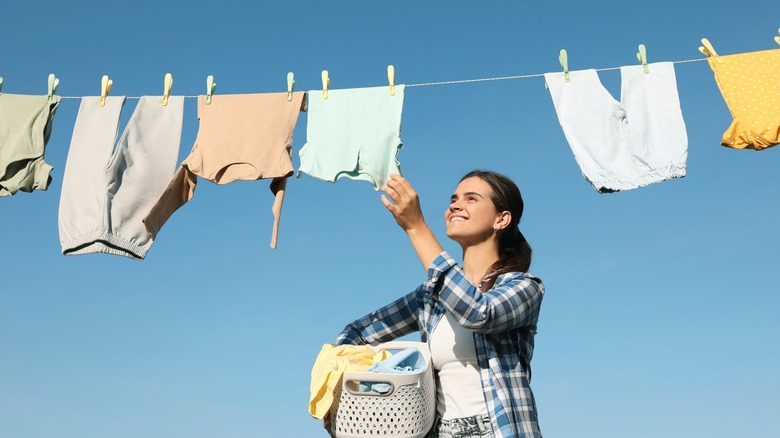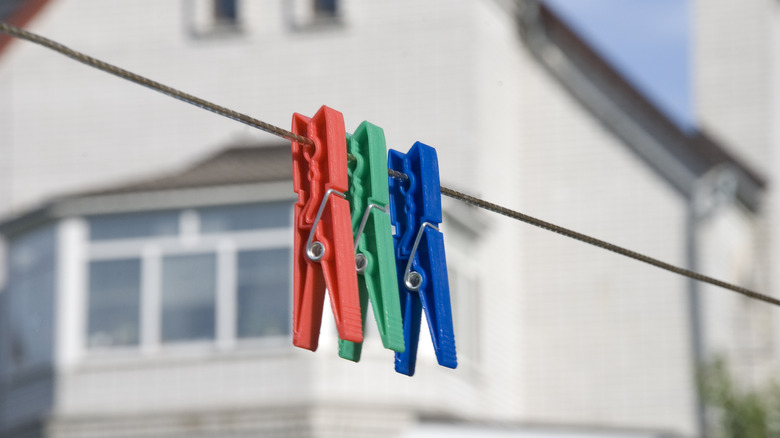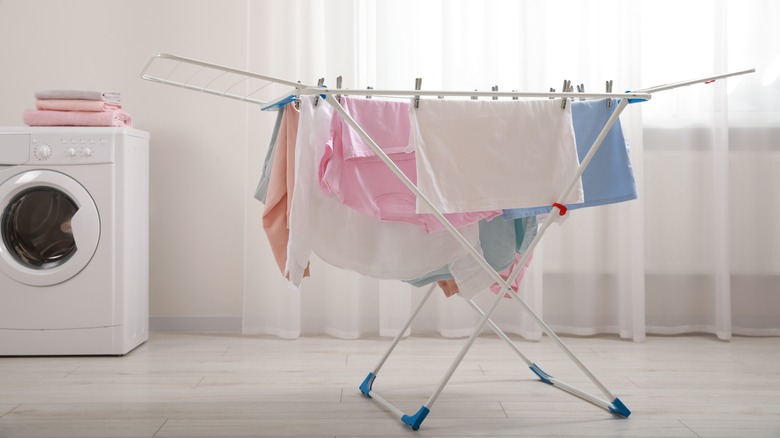What To Consider Before Installing A Clothesline In Your Outdoor Space
For most people, clotheslines seem to evoke either images of snowy-white laundry blowing in a gentle sunlit breeze, or lines strung across an urban alley or a backyard in hardscrabble Appalachia. But the reality is that there's something for everyone in a clothesline, from busy professionals drying delicates to even busier homesteaders ducking under a line of drying gloves and cloth diapers en route to the chicken coop. Some of the images that clotheslines conjure up –- though probably not the idyllic fabric softener ads –- are the very reasons that many communities have made efforts to ban outdoor clotheslines. Hanging your laundry to dry outdoors, they argue, undermines the tidy, more upscale vibe many such communities are striving for.
Of course, most people don't use clotheslines because of their unreconstructed messiness or financial challenges. Clotheslines certainly are dirt cheap, but they're also eco-friendly, easy on your clothes, and can save you from draping hand-wash items all over your bathroom. Since the ultraviolet component of sunlight is a well-established means of disinfection, outdoor clotheslines also help in keeping things truly clean. And there's no reason you can't have both a tumble dryer and a clothesline. Well, no reason for most people.
When You Might Not Be Able to Use a Clothesline Outdoors
More than half of the US population, about 54%, lives in states that have "right to dry" laws that block HOAs and condo associations from prohibiting your clothesline. Even in states with right-to-dry laws, some restrictions on the use and placement of clotheslines are likely. In California, for example, HOAs can still control where your clothesline can be installed, and even what type of clotheslines are allowed. (There are a surprising number of permanent and portable clotheslines, from ordinary pole-to-pole and line-and-pulley lines to retractable, umbrella, tripod, and wall-mounted versions.) The purpose of covenants is usually to protect a neighborhood's aesthetics, so HOAs in right-to-dry states might also find other ways of accomplishing this, such as by restricting the height of clotheslines to limit their visibility.
Outside of these "solar access" states, the covenants, conditions, and restrictions on clotheslines can be more far-ranging. These might ban clotheslines entirely, or restrict them so severely that they become impractical, such as limiting them to fully enclosed "service yards" that most homeowners don't have and might not want. Also note that HOAs have no choice but to enforce their rules, regardless of circumstances, since not doing so can result in their inability to enforce them at all.
Is Drying Indoors a Better Idea?
What about stringing up a clothesline inside? Generally speaking, outdoor clotheslines are more effective than indoor lines. According to Christopher Baird, a physics professor at West Texas A&M University, the rate at which clothes dry on a clothesline is affected by the temperature of the water on the clothes, the relative humidity, and the rate of airflow around the clothes. In most cases, these factors add up to outdoor clotheslines that perform better than their indoor cousins. And, as we've seen already, UV light makes outdoor lines more effective at removing stains and odors. There's also a potential downside of indoor lines that might make you think twice before hang-drying your laundry indoors: they can increase indoor humidity to undesirable levels.
There are cases where indoor clotheslines are a great solution, though. Consider the indoor humidity problem mentioned above. In some cases, an indoor clothesline can improve indoor air quality during winter or in dry areas by increasing the humidity inside your home. Some models even improve their effectiveness by adding fans to closely emulate outdoor lines. And since you're unlikely to install an indoor clothesline that can't be hidden, such as a retractable model, they usually take up practically no space when they're not in use. There are, in fact, lots of air-drying alternatives that are perfect for when you don't (or can't) have a clothesline; it's just a matter of finding the combination that works best for you.


